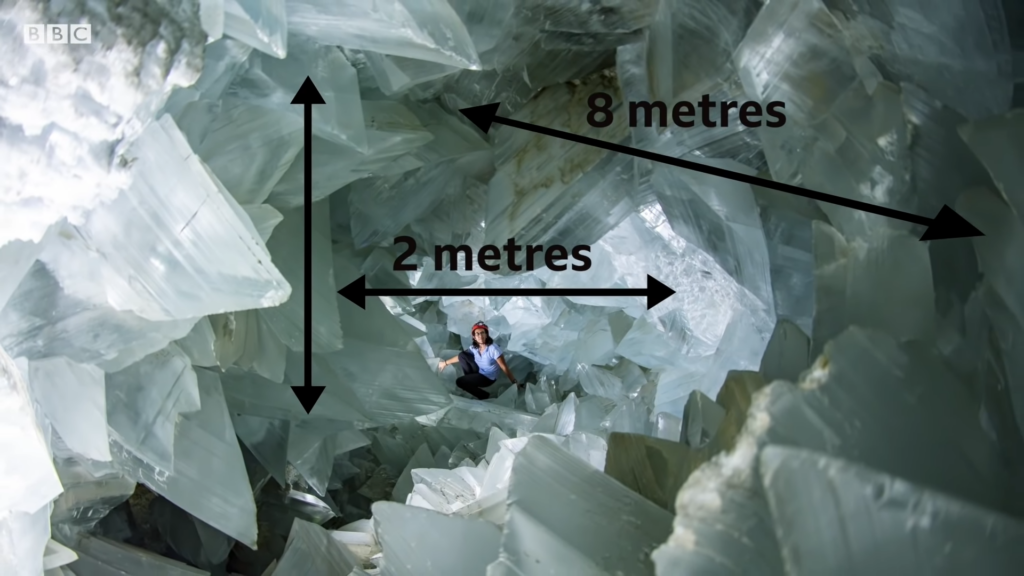Deep within an abandoned silver mine in Spain’s Almería Province lies a hidden wonder: the Pulpí Geode. Discovered in 1999, this astonishing geological phenomenon has captivated scientists and adventurers alike with its spectacular human-size gypsum crystals that adorn its walls.
The Pulpí Geode is not only a stunning visual marvel, but also an intriguing study in the formation of these otherworldly crystals. Measuring up to seven feet long, the crystals within the Pulpí Geode stand as testament to nature’s capacity to create awe-inspiring beauty. The geode itself is one of the largest and most accessible in the world, making it an enticing destination for those eager to explore its fascinating depths.
Located 164 feet below the surface in Mina Rica, this monumental geode has a history dating back over 250 million years to the time of the dinosaurs. With such a rich past, the Pulpí Geode offers not only an unparalleled visual experience but also a peek into the geological secrets that led to the creation of these remarkable human-size crystals.
Inside the Pulpi Geode
Discovery of the Pulpí Geode
In 1999, an extraordinary discovery was made within an abandoned silver mine in Spain’s Almería Province. While exploring the depths of the mine, scientists stumbled upon a hidden treasure, the Pulpí Geode, which is now known as one of the world’s largest.
The Pulpí Geode, also referred to as the Giant Geode, has a cavity about 390 cubic feet in volume. Its walls are adorned with stunning, human-sized crystals, capturing the awe and fascination of anyone who has the privilege of witnessing this natural wonder. The geode is located in Mina Rica, near the town of Pulpí, along the northern Almeria coast.
The geological phenomenon has since become a major point of interest to researchers and enthusiasts alike. The crystals inside the Pulpí Geode are so large and magnificent that they are considered a true masterpiece of nature. In fact, the geode is so remarkable that it attracts visitors from all over the world who come to appreciate the breathtaking beauty of the crystal formations.
Scientists have been diligently studying how these enormous crystals formed within the Pulpí Geode. The process is believed to have occurred when the Mediterranean Sea disappeared, causing mineral-rich water to fill the cavity, eventually leading to the formation of these beautiful crystal structures.

Formation and Composition
Giant Gypsum Crystals
These magnificent gypsum crystals originated less than 2 million years ago through a slow-growing process known as Ostwald ripening. This process occurs when larger crystals continue to grow while smaller ones dissolve, leading to the formation of the spectacular selenite crystals seen in the Pulpí Geode today.
Geological Conditions
The intricate formation of the large selenite crystals within the geode is the result of a self-feeding mechanism. This mechanism involves isovolumetric anhydrite replacement by gypsum at a temperature of around 20 ± 5 °C, contributed episodically by a ripening process enhanced by temperature oscillations due to climatic change. The unique geological conditions present in the Pulpí Geode have allowed these mesmerizing structures to thrive, making it an extraordinary example of nature’s stunning creations.
World Records and Comparisons
Cave of the Crystals
One of the most remarkable natural crystal formations in the world, the Cave of the Crystals, is located in Naica, Mexico. This cave is home to gigantic selenite crystals, some reaching over 36 feet in length and 13 feet in diameter. Like the Pulpí Geode, these colossal crystals were also formed in unique geological conditions, particularly high temperatures and mineral-rich waters.
While the Pulpí Geode’s gypsum crystals are transparent and resemble ice, the Cave of the Crystals selenite structures are more translucent but equally spectacular. Both the Pulpí Geode and the Cave of the Crystals are testaments to nature’s ability to create masterpieces that astonish and inspire.
Other Giant Geodes
Though the Pulpí Geode is the world’s largest, there are several other sizable geodes across the globe. Some noteworthy examples include:
- Crystal Cave of Bermuda: Located in Hamilton Parish, this cave showcases intricate white crystal formations that line its walls and ceilings, offering a stunning backdrop for the azure waters below.
- Erawan Museum: Situated in Samut Prakan, Thailand, this museum houses a three-headed elephant sculpture adorned with one of the largest accessible amethyst geodes in the world, standing at an impressive 14 feet in height.
- Giant Geode of Put-in-Bay: Found in South Bass Island, Ohio, USA, this geode, also known as Crystal Cave, boasts walls lined with strontianite crystals measuring up to 18 inches long.
These colossal geodes, along with the Pulpí Geode, showcase the extraordinary beauty and diversity of our planet’s geological wonders. The exceptional quality and size of the crystals found within these formations continue to captivate the curiosity and imagination of scientists, explorers, and enthusiasts alike.
- Online rock and mineral club for collectors of all levels!
- Find community with like-minded rock and mineral enthusiasts.
- Monthly Giveaways!
- Free Access to Entire Digital Library of Products (annual memberships)


